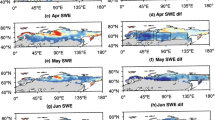Summary
A hydro-thermodynamic soil-vegetation model including soil freezing/thawing (soil-frost) and snow-metamorphism has been integrated into the PennState/NCAR Mesoscale Meteorological Model MM5 in a two-way coupled mode. A hierarchy of simulations with and without the soil-frost module, each combined with and without the snow module, shows the influence of snow-cover and soil-frost on weather in Alaska. Herein the landscape is featured as it is typically by mesoscale models.
Theoretical considerations suggest that organic soil types should be considered in mesoscale modeling because of their different thermal and hydrological behavior as compared to mineral soils. The Ludwig-Soret and Dufour effects are small, but increase appreciably during freezing/thawing and snow-melt.
The snow and soil-frost processes have a demonstrable impact on the surface thermal and hydrological regimes and on the near-surface atmospheric conditions even on the short (synoptic) timescales. The presence of snow-cover results in a highly stable stratification. In cloud-free areas, the enhanced loss of radiant energy and cooling of the air over snow-cover lead to a positive feedback to relatively colder, drier conditions. In cloudy areas, a positive feedback to warmer, moister conditions develops over snow-cover. As the changes in atmospheric humidity and temperature caused by snow-cover propagate into the pressure field, sea level pressure is lower by more than 1 hPa in the simulations with snow-cover. Although the effect of soil-frost alone is an order of magnitude smaller, the soil-frost snow system leads to an increase of the pressure difference to 1.2 hPa. The changes in the pressure field alter wind speed and direction slightly.
Soil-frost results in soil temperature differences of 2–5 K in the upper soil layers, while snow results in differences of 3–10 K. Soil-frost has a notably greater impact in cloud-free than cloudy areas. When a snow-cover is present, frozen soil enhances the insulating effect of a snow-cover in cloudy areas, but reduces it in cloud-free areas. In cloudy areas, soil-frost without snow-cover leads to cooler, drier atmospheric conditions relative to no frost. In cloudy areas, soil-frost under a snow-cover reduces the water supply to the atmosphere as compared to snow-covered conditions without soil-frost. The combined effects of soil-frost and snow increase precipitation locally by as much as 12.2 mm/ 48 h. If mesoscale modeling does not consider the soil-frost snow system, predicted water vapor fluxes will be too high in cloud-free areas, and too low in cloudy areas.
Similar content being viewed by others
Author information
Authors and Affiliations
Rights and permissions
About this article
Cite this article
Mölders, N., Walsh, J. Atmospheric response to soil-frost and snow in Alaska in March. Theor Appl Climatol 77, 77–105 (2004). https://doi.org/10.1007/s00704-003-0032-5
Received:
Revised:
Accepted:
Published:
Issue Date:
DOI: https://doi.org/10.1007/s00704-003-0032-5




